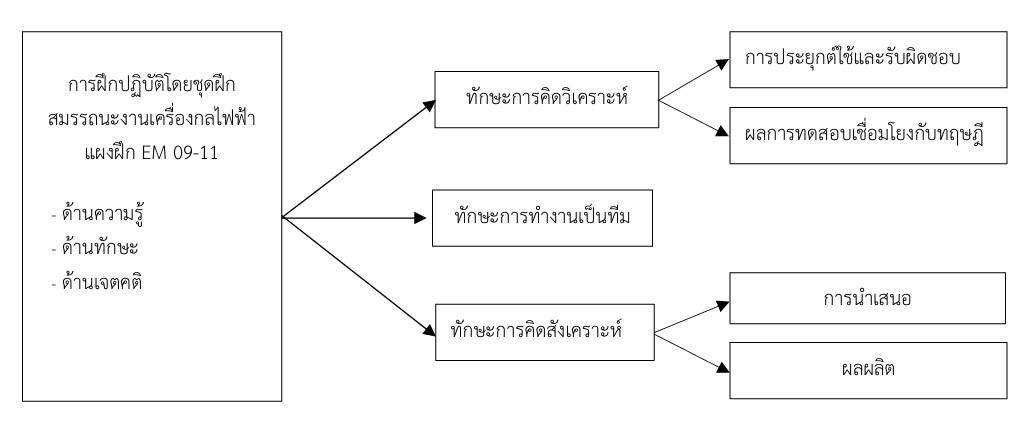The Development of The EM 09-11 Electrical Machinery Competency Training Set for Vocational Education
Main Article Content
Abstract
This research article aims to (1) develop and evaluate the effectiveness of the EM 09 – 11 Electrical Machinery Competency Training Set, (2) compare the learning achievements of students using the EM 09 – 11 Electrical Machinery Competency Training Set with those using traditional learning methods, (3) compare the students’ post-learning competency scores obtained through the use of the Electrical Machinery Competency Training Set (Panels EM 09–11) with the criterion level of 60 percent, and (4) study the satisfaction of students using the EM 09 – 11 Electrical Machinery Competency Training Set. This research is a quasi-experimental study that employs the 4D Model concept as the framework. The sample group consisted of students from the Electrical Department of Nakhon Si Thammarat Technical College, Semester 2, Academic Year 2024, obtained through cluster random sampling, divided into an experimental group of 21 individuals and a control group of 14 individuals. The tools used for data collection included achievement tests and satisfaction questionnaires. The statistics used for data analysis included percentages, means, standard deviations, and t-tests for independent samples. The study found that 1) the analysis of expert opinions on the EM 09 – 11 Electrical Machinery Competency Training Set showed a high average level (M = 4.45, S.D. = 0.44). The performance test results met the requirements with 100% compliance, and the average process score to average outcome score ratio of students who learned using the EM 09 – 11 Electrical Machinery Competency Training Set was 81.59/80.58, meeting the set criteria of 80/80. 2) The post-test mean score of students who learned with the EM 09-11 set was significantly higher than that of those taught through traditional methods at the .05 level of significance. 3) The competency scores of students in the experimental group after the learning intervention were significantly higher than the criterion level of 60 percent at the .05 level of significance. 4) The satisfaction level of students who learned with the EM 09 – 11 Electrical Machinery Competency Training Set was at a high level (M = 4.49, S.D. = 0.56).
Article Details

This work is licensed under a Creative Commons Attribution-NonCommercial-NoDerivatives 4.0 International License.
References
ฉัตรชัย สุขุม และ ศิริวรรณ วณิชวัฒนวรชัย. (2566). การออกแบบการเรียนรู้ฐานสมรรถนะ แนวคิด การออกแบบการเรียนการสอนและการประเมินผลการเรียนรู้. วารสารวิจัยและพัฒนา มหาวิทยาลัยราชภัฏสวนสุนันทา, 15(1), 65-78.
ชัยยงค์ พรหมวงศ์. (2556). การทดสอบประสิทธิภาพสื่อหรือชุดการสอน. วารสารศิลปะกรศึกษาศาสตร์วิจัย, 5(1), 7-20.
บุญชม ศรีสะอาด. (2560). วิธีการทางสถิติสำหรับการวิจัย. (พิมพ์ครั้งที่ 10). กรุงเทพฯ: สุริยาศาสตร์.
พงษ์ศักดิ์ ผกามาศ และ ดรุณี ปัณจรัตนากร. (2566). สถาปัตยกรรมการจัดการศึกษาฐานสมรรถนะตามแนวทางปฏิรูปการศึกษาในศตวรรษที่ 21. วารสารวิจัยเพื่อการปฏิรูปการเรียนรู้, 6(1), 36-50.
พิมพันธ์ เดชะคุปต์, พเยาว์ ยินดีสุข และ พรเทพ จันทรานุกฤษฎ์. (2566). การเรียนรู้เชิงรุกเสริมสร้างสมรรถนะ. กรุงเทพฯ: จุฬาลงกรณ์มหาวิทยาลัย.
เลอพงษ์ สุวรรณนันท์. (2568). การสร้างและพัฒนาชุดฝึกสมรรถนะงานต่อระบบควบคุมมอเตอร์ปั๊มน้ำอาคารสูง. วารสารวิจัยมหาวิทยาลัยเวสเทิร์น มนุษยศาสตร์และสังคมศาสตร์, 11(2), 197-212.
วนิดา วาดีเจริญ, รังสรรค์ เลิศในสัตย์ และ สมบัติ ทีฑทรัพย์. (2560). ระเบียบวิธีวิจัย จากแนวคิด ทฤษฎี สู่ภาคปฏิบัติ. กรุงเทพฯ: ซีเอ็ดยูเคชั่น.
วิชญนาถ เรืองนาค. (2563). ผลการจัดการเรียนรู้ฐานสมรรถนะที่มีต่อชีวิตและการทำงานของนักเรียนชั้นมัธยมศึกษา ในวิชาสุขศึกษา โดยใช้การเรียนรู้ที่ใช้ปัญหาเป็นฐาน. (ครุศาสตรมหาบัณฑิต, จุฬาลงกรณ์มหาวิทยาลัย).
สัญญา โพธิ์วงษ์. (2567). การพัฒนาชุดฝึกสมรรถนะงานเครื่องเสียง บอร์ด SMP 88-96 วิชาเครื่องเสียง รหัสวิชา 20105-2008. วารสารวิชาการครุศาสตร์อุตสาหกรรมและวิศวกรรมศึกษา, 15(3), 82-96.
สำนักงานคณะกรรมการการอาชีวศึกษา. (2567). หลักสูตรประกาศนียบัตรวิชาชีพชั้นสูง พุทธศักราช 2567. สืบค้นจาก https://bsq.vec.go.th/Portals/9/Course/30/2567/30100/30104v6.pdf.
สำนักงานพัฒนาเศรษฐกิจและสังคมแห่งชาติ. (2565). แผนพัฒนาเศรษฐกิจและสังคมแห่งชาติ ฉบับที่สิบสาม. สืบค้นจาก https://bic.moe.go.th/images/stories/pdf/แผนพัฒนาเศรษฐกิจและสังคมแห่งชาติ_ฉบับที่13_4-11-2565.pdf.
สำนักงานเลขาธิการวุฒิสภา. (2567). รายงานการพิจารณาศึกษา เรื่อง ความท้าทายต่อการเปลี่ยนแปลงในการจัดการ อาชีวศึกษาแนวใหม่เพื่อการพัฒนาประเทศ. กรุงเทพฯ: สำนักงานเลขาธิการวุฒิสภา.
สำนักงานเลขาธิการสภาการศึกษา. (2566). เข้าใจสมรรถนะอย่างง่าย ๆ ฉบับประชาชน และเข้าใจหลักสูตรฐานสมรรถนะอย่างง่าย ๆ ฉบับครู ผู้บริหาร และบุคลากรทางศึกษา (ฉบับปรับปรุง). กรุงเทพฯ: บริษัท 21 เซ็นจูรี่ จำกัด.
สำนักงานเลขาธิการสภาการศึกษา. (2567). การศึกษาแนวทางการผลิตบัณฑิตที่มีสมรรถนะสูง เพื่อตอบโจทย์ความต้องการของประเทศ (รายงานการวิจัย). กรุงเทพฯ: บริษัท พริกหวานกราฟฟิค จำกัด.
สำนักมาตรฐานการอาชีวศึกษาและวิชาชีพ. (2567). ประกาศกระทรวงศึกษาธิการ เรื่อง กรอบคุณวุฒิอาชีวศึกษาแห่งชาติ พ.ศ. 2567. สืบค้นจาก http://bsq2.vec.go.th/crouse_manage/%E0%B8%81%E0%B8%A3%E0%B8%AD%E0%B8%9A%E0%B9%80%E0%B8%81%E0%B8%93%E0%B8%91%E0%B9%8C67/%E0%B8%81%E0%B8%A3%E0%B8%AD%E0%B8%9A%E0%B8%84%E0%B8%B8%E0%B8%93%E0%B8%A7%E0%B8%B8%E0%B8%92%E0%B8%B4%E0%B8%AD%E0%B8%B2%E0%B8%8A%E0%B8%B5%E0%B8%A7%E0%B8%A8%E0%B8%B6%E0%B8%81.pdf.
อิทธิพัทธ์ สุวทันพรกูล. (2562). การวิจัยทางการศึกษา แนวคิดและการประยุกต์ใช้. (พิมพ์ครั้งที่ 2). กรุงเทพฯ: จุฬาลงกรณ์มหาวิทยาลัย.
เอกชัย ไก่แก้ว, กิตติศักดิ์ คำผัด, วุฒิชัย คำมีสว่าง, ดำรงค์ สุพล และ ทวี ไพกุมภัณฑ์. (2564). ชุดฝึกสมรรถนะงานสื่อสารผ่านใยแก้วนำแสง. วารสารวิศวกรรมศาสตร์ มหาวิทยาลัยเทคโนโลยีราชมงคลล้านนา, 6(2), 19-28.
Adlini, M. N., Jayanti, U. N. A. D., & Wiryawan, Y. N. R. (2024). Designing educational resources of the 21st-century skills instructional models and socio-scientific issues integration. Research and Development in Education, 4(2), 1123–1141.

